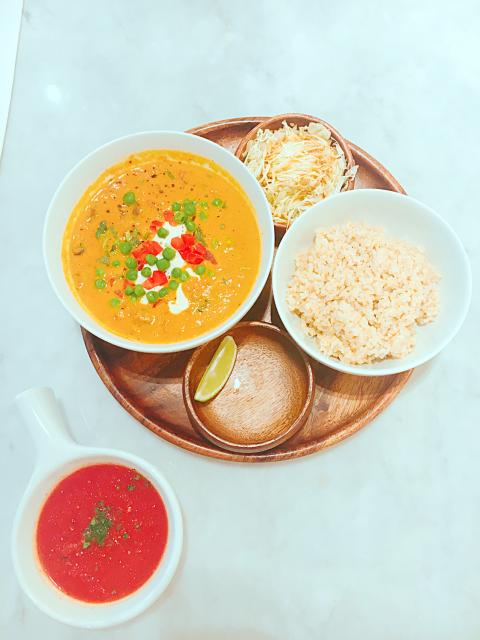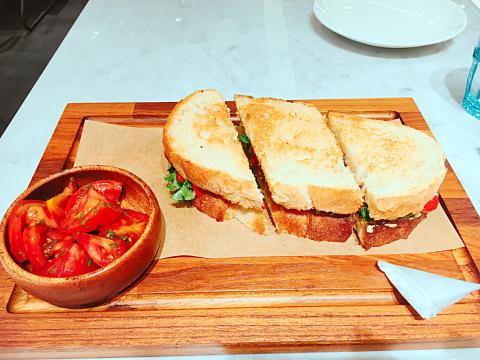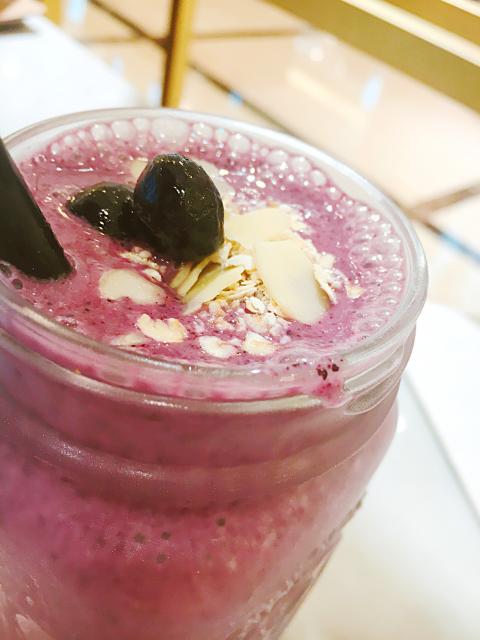The Mia Cucina chain of restaurants has long been lauded in Taipei as the pinnacle of Western-style vegan-friendly cuisine, a prime destination for discerning carnists and vegheads alike. Fresh produce, a plethora of choices and authentic flavors are its calling card.
Herbivore Vegan Restaurant, located on the 2nd floor of the posh Shinkong Mitsukoshi in Xinyi District, is the sophomore effort by the same group, and their first entirely plant-based one. Unlike traditional local cuisine, the menu is light on soy products and heavy on fresh greens and intense flavor. Almost too intense, as the saline glaze didn’t leave my tongue for hours after every meal.
The servingware and plating are on point — polished wood, earthy ceramic and rich gold cutlery — and so is the service, exemplified by the waiter who gave me extra napkins when he noticed that I wasn’t using the folded plastic glove that came with the heavenly hummus sandwich, and the waitress who kindly requested more almondmilk on my behalf when the blueberry smoothie turned out too sweet.

Photo: Darice Chang
My first encounter was through my roommate, a fellow vegan who had gone shortly after opening. “We ordered a bit too much, would you want to try the leftovers?” ended with half a black bean burger and a generous portion of the fattest fluffiest chocolate banana pancake I’ve had in quite awhile. The BBQ burger (NT$360) was the most authentic I’ve had in Taipei — filled with tangy housemade mozzarella barbeque sauce. I knew I had to go.
On my initial foray I had the grilled vegetable hummus sandwich (NT$350) and, because it took them almost 20 minutes to make, a side of the soup of the day (NT$180), which was mushroom barley. I wanted to like the soup, chock-full of thick slices of button mushroom and fat Western celery, finely diced carrots and toothsome kernels of cooked-from-scratch barley, but it tasted like doctored up Campbell soup. Not very classy.
The shining star of the meal was the hummus sandwich, which came neatly sliced into thirds. Two enormous slices of crusty bread, grilled with fragrant olive oil and slathered thickly with basil pesto and chickpea hummus then stuffed with satisfying slices of grilled eggplant, zucchini and marinated red pepper. The menu said it is accompanied by corn salsa, but mine arrived with balsamic infused tomatoes. These, too, were a disappointment: crimson quarters of tasteless fruit slippery with oil and marinated just not-long-enough to impart anything more than a whisper of acidic aroma.

Photo: Darice Chang
A working day led me to try their berry hazelnut smoothie (NT$240), a bright antioxidant-filled concoction rife with blueberries, hazelnut, banana, oats, almond milk and a touch of house-made syrup, which isn’t listed on the menu but was revealed by the waitstaff when it proved too sweet for my taste.
I was a bit disappointed they were using Almond Breeze from a carton instead of making their own milk from scratch, like Plants or Naked Food, especially considering the price. Others diners, however, haven’t found fault with it.
On an outing with friends, both vegan and omnivores, we were delighted by the almond milk cappuccino (NT$160), topped with a thick creamy foam, as well as the sweet potato chickpea coconut curry (NT$430) and mango tofu masala curry (NT$430), which are portioned generously and served with brown rice and a side of roasted tomato soup.

Photo: Darice Chang
Both the curries, thick and full of fresh vegetables, tended to be sweet, per the local preference, but are bettered with the addition of lime. Our adventurous friend decided on a spicy tex mex burger (NT$380), which was dense and flavorful, loaded with avocados and pickled jalapenos and served with fries and an amazing tomato-based spicy-sour dipping sauce.
Dessert options include cakes, candies and pancakes. The strawberry pancake (NT$360) was a favorite and chocolate hazelnut tart (NT$260) was akin to a Ferrero Rocher in French Silk pie form. The crust was especially delightful — tender, full of nutty aroma with a fine crumb. The green tea chocolate caramel truffle (NT$260, 3 pieces) tasted like matcha almond joy with peanut butter drizzle, and was quickly devoured.
Herbivore is without competition in Taipei in terms of atmosphere, bringing pure plant cuisine to new heights. The location and decor says it all: classy and upscale yet casual with beautiful green walls featuring real plants, though a friend was miffed it’s basically in the middle of a mall.
Instgrammers may bemoan the lighting, which is not great for overhead shots, but a true dedicate would bring their own. Or, just enjoy the food. That’s what it’s there for.

June 9 to June 15 A photo of two men riding trendy high-wheel Penny-Farthing bicycles past a Qing Dynasty gate aptly captures the essence of Taipei in 1897 — a newly colonized city on the cusp of great change. The Japanese began making significant modifications to the cityscape in 1899, tearing down Qing-era structures, widening boulevards and installing Western-style infrastructure and buildings. The photographer, Minosuke Imamura, only spent a year in Taiwan as a cartographer for the governor-general’s office, but he left behind a treasure trove of 130 images showing life at the onset of Japanese rule, spanning July 1897 to

One of the most important gripes that Taiwanese have about the Democratic Progressive Party (DPP) is that it has failed to deliver concretely on higher wages, housing prices and other bread-and-butter issues. The parallel complaint is that the DPP cares only about glamor issues, such as removing markers of Chinese Nationalist Party (KMT) colonialism by renaming them, or what the KMT codes as “de-Sinification.” Once again, as a critical election looms, the DPP is presenting evidence for that charge. The KMT was quick to jump on the recent proposal of the Ministry of the Interior (MOI) to rename roads that symbolize

On the evening of June 1, Control Yuan Secretary-General Lee Chun-yi (李俊俋) apologized and resigned in disgrace. His crime was instructing his driver to use a Control Yuan vehicle to transport his dog to a pet grooming salon. The Control Yuan is the government branch that investigates, audits and impeaches government officials for, among other things, misuse of government funds, so his misuse of a government vehicle was highly inappropriate. If this story were told to anyone living in the golden era of swaggering gangsters, flashy nouveau riche businessmen, and corrupt “black gold” politics of the 1980s and 1990s, they would have laughed.

It was just before 6am on a sunny November morning and I could hardly contain my excitement as I arrived at the wharf where I would catch the boat to one of Penghu’s most difficult-to-access islands, a trip that had been on my list for nearly a decade. Little did I know, my dream would soon be crushed. Unsure about which boat was heading to Huayu (花嶼), I found someone who appeared to be a local and asked if this was the right place to wait. “Oh, the boat to Huayu’s been canceled today,” she told me. I couldn’t believe my ears. Surely,